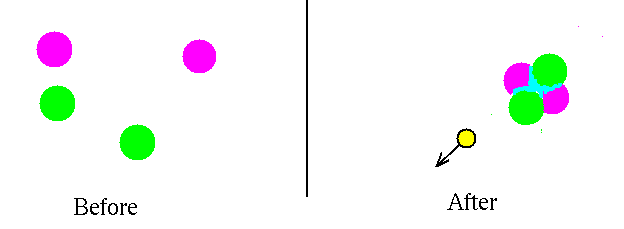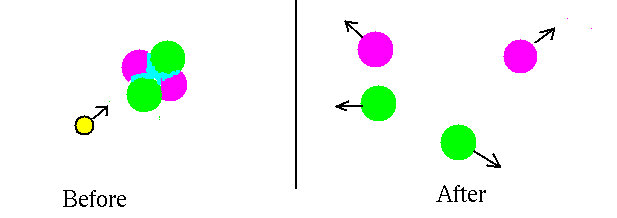When the temperature was 0.3 MeV to 0.1 MeV
t ~ 1 to 3 minutes
Why bother with this?
- It's interesting to learn about how the universe got started.
- Some things that happened at this time (according to the model)
left imprints on the current universe that can be tested.
At earlier times, you could make a 4He nucleus from two
protons and two neutrons.

But would be broken up by high energy
collisions.

Specifically
- The binding energy of 4He is 28.3 MeV.
- That is how much energy it takes to break up a 4He
into two protons and two neutrons
- But there are lots of photons available to do the breaking up.
- And there are not many protons and neutrons available to make nuclei.
- Calculations show that, given the number of photons, protons
and neutrons should start to combine to make 4He when
the temperature drops below 0.3 MeV.
When the temperature did drop below 0.3 MeV, 4He
production started.
This was a multistep process, beginning with production of 2H.
For example
- p + n --> 2H + photon
 .
.
- 2H + 2H --> 3He + n
 .
.
- 3He + 2H + --> 4He + p
 .
.
At the time, the ratio of neutrons to protons had dropped to 1/7. Thus
we can count how much 4He we make.

We see that there are 4 particles out of 16 made into helium, so the ratio
of the mass of helium to the total mass is 1/4.
The predicted helium abundance matches observation.
Observation
- The observation is difficult.
- Looking at a range of objects gives a range values for the fractional
helium abundance.
- That is becaue helium is made in stars.
- So you want to look at old, ``metal poor'' objects
- ie objects that don't have much of the elements beyond helium.
- These objects presumably have not had much material recycled from
stars.
- Such studies give estimated primordial helium abundance of
about 0.24.
Theory
- Careful theory involves computer modelling of all the reactions.
- The answer agrees with a helium abundance of 0.24.
- But
one needs to assume a density of normal matter (made of neutrons
and protons) that is not too big.
- If you think that the total mass density of the universe is the
critical value needed to just close the universe AND
- if you think that this matter is all proton and neutron matter THEN
- the helium abundance comes out wrong.
A Conclusion
- IF the the total mass density of the universe is the
critical value needed to just close the universe
- THEN most of the dark matter must be something other than protons
and neutrons.
Other nuclei
The same theoretical model predicts that small amounts of
were made. The predicted primordial abundance of these elements match
observations pretty well.
Nuclei heavier than this were not made. By the time it was cool enough, the
density of matter was too small for the lighter nuclei to find each other.
Davison E. Soper, Institute of Theoretical Science,
University of Oregon, Eugene OR 97403 USA
soper@bovine.uoregon.edu



 .
.
 .
.
 .
.
